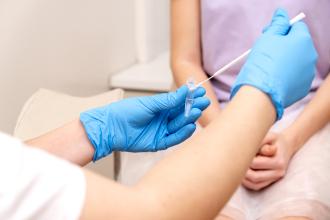Recommended use of point-of-care HIV tests
Point-of-care HIV tests are screening tests for use in the clinic setting that provide immediate results on fingerstick blood specimens. These antibody-based tests have similar properties to laboratory-based screening tests (e.g., high sensitivity and specificity, a 3-month window period) and confirmatory lab-based testing for preliminary positive results is essential. All preliminary positive point-of-care HIV test results must be reported to the local medical health officer. Knowing how to use these tests and interpret the test results can help physicians provide appropriate pre- and post-test counseling to patients in their care, and assist in incorporation of this testing method into clinical practice.
What is a point-of-care HIV test?
A point-of-care (POC) HIV test (also known as rapid antibody tests) are HIV tests licensed by Health Canada that can be administered by health care professionals in the clinic setting. These single-use tests consist of the collection and testing of an appropriate specimen (fingerstick blood, saliva) with results available in 1 to 5 minutes. POC HIV tests are screening tests based on the presence of antibodies to HIV, and are similar to existing laboratory-based screening HIV tests. POC HIV tests have high sensitivity and specificity (≥99.0%), and the majority of individuals will produce antibodies detected by POC HIV tests within 3 months of infection (i.e., a window period of 3 months). As screening tests, POC HIV tests can yield false positive results (particularly in low HIV prevalence populations) and therefore subsequent lab-based confirmatory testing is required. POC HIV tests may also vary in their ability to discriminate between HIV-1 and HIV-2. POC HIV test kits are not currently funded through the Medical Services Plan and must be purchased directly from the manufacturer.
When could POC HIV tests be used in my clinic?
POC HIV tests may be a useful screening test for providing care to patients when there is a need for immediate knowledge of negative or preliminary positive HIV status, or for use with patients who cannot or will not access standard lab-based HIV testing (e.g., may not return for a follow-up appointment to receive results).
What follow-up is required for POC HIV test results?
There are four possible outcomes:
1. Negative result: no further testing is required. If your patient has a history of recent high-risk activity, repeat testing is recommended at least 3 months after the last high-risk exposure.
2. Preliminary positive result: must be confirmed using standard laboratory testing for HIV as described above. Under the BC Health Act, HIV is a reportable infection and all preliminary positive results must be reported to your local medical health officer.
3. Indeterminate results (visually appears positive, but not certain): repeat POC HIV test. If second test remains indeterminate then one cannot interpret the result with confidence and routine lab-based testing should be obtained.
4. Invalid test (cannot determine test result): repeat POC HIV test. If second test remains invalid then obtain routine lab-based HIV testing. Possible device failures should be reported to the manufacturer and to Health Canada.
How do I counsel my patients when using these tests?
Pre- and post-test counseling should also be provided to your patients when using POC HIV tests as for other HIV testing methods. In addition to routine components (i.e., assessment of risk, risk-reduction strategies, readiness to receive positive test results), during pre-test counseling patients should be provided with information about the test itself, informed of the 3-month window period following infection when the POC HIV test may be negative, and told that preliminary positive results need confirmation by standard laboratory testing procedures.
Are there any special considerations for using these tests?
Appropriate quality assurance measures are required for physicians’ offices using POC HIV test kits. Important measures include staff training in appropriate use of the test kit (according to manufacturer’s specifications) and maintaining appropriate documentation (in the client chart or on a test kit log including client name, test kit lot number, date of test, and result) in event of a product quality concern. Periodic quality-control testing is recommended using commercially available quality-control kits (containing samples negative and positive for HIV).
Where can I get more information about POC HIV tests?
Detailed guidelines for the use of POC HIV test kits, and client counseling guidelines for use with POC HIV test kits, are available on the BCCDC web site(www.bccdc.org/content.php?item=83). Currently one licensed POC HIV test kit (using fingerstick blood) is available in Canada (INSTI HIV-1 Rapid Antibody Test, bioLytical Laboratories, tel (toll free): 866 674-6784). The BCCDC recommends that external quality control measures be in place for all types of POC HIV test kits in use in BC (i.e., quality control conducted by an organization independent of the manufacturer). Please refer to the BCCDC guideline for the use of POC HIV test kits for updated information regarding available products and the presence of external quality control measures.
—M. Gilbert, MD, FRCP
BC Centre for Disease Control
—E. Wong, BSN, MBA
Public Health Agency of Canada
—D. Spencer, RN
BC Centre for Disease Control
—M.L. Rekart, MD, FRCP
BC Centre for Disease Control

